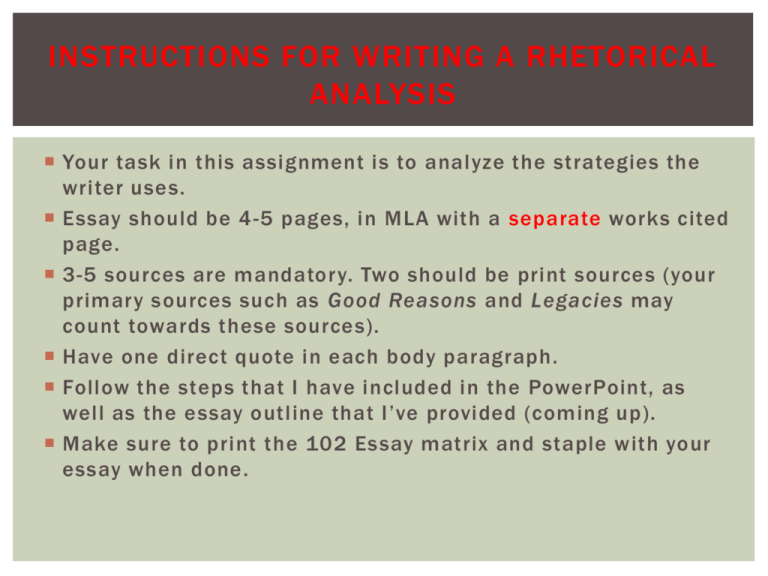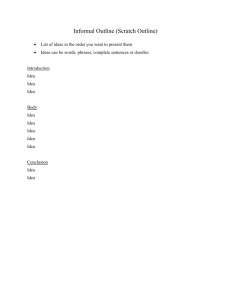Rhetorical Analysis (69
advertisement

INSTRUCTIONS FOR WRITING A RHETORICAL ANALYSIS Your task in this assignment is to analyze the strategies the writer uses. Essay should be 4-5 pages, in MLA with a separate works cited page. 3-5 sources are mandatory. Two should be print sources (your primary sources such as Good Reasons and Legacies may count towards these sources). Have one direct quote in each body paragraph. Follow the steps that I have included in the PowerPoint, as well as the essay outline that I’ve provided (coming up). Make sure to print the 102 Essay matrix and staple with your essay when done. RHETORICAL ANALYSIS (69-89 GR) Rhetorical Analysis can be defined as an effort to understand how people attempt to influence others through language and more broadly every kind of symbolic action—not only speeches, articles and books, but also architecture, movies, television shows, memorials, Web sites, advertisements, photos and other images, dance and popular songs. TEXTUAL AND CONTEXTUAL ANALYSES Textual Analysis concentrates more on texts than on contexts. They typically use rhetorical concepts to analyze the features of texts. --How does King use ethos, pathos, and logos to persuade his audience? --How does his tone influence his audience? It focuses on mainly what’s written/being stated and doesn’t focus on external influences. Contextual Analysis focuses on reconstructing the cultural environment, or context, that existed when a particular event took place. --What external/social situations motivated King’s “Letter From Birmingham Jail” --What were rights did women have when Woolf and De Beauvoir have when they wrote their essays? Contextual Analysis regards communications as anything but self contained. USE BOTH FOR AN EFFECTIVE ANALYSIS But we should emphasize that these two approaches to rhetorical analysis are not mutually exclusive. Textual analysis and contextual analysis inevitably complement each other. STEPS TO WRITING A RHETORICAL ANALYSIS (64-65 IN GR) Organize your paper in the following order: INTRODUCTION Begin with a hook/attention grabber Introduce your text and author, describe briefly the argument you are analyzing, and supply the necessary background State you thesis as the last sentences (sentences) of the introduction paragraph THESIS STATEMENTS FOR RHETORICAL ANALYSIS Your task in this assignment is to analyze the strategies the writer uses. The texts for consideration for this essay be on one or a couple of the following: King’s “Letter From Birmingham Jail” Camus’ “The Myth of Sisyphus” Plato’s “The Allegory of the Cave” Woolf’s “Professions for Women” De Beauvoir’s “Woman as Other” Marable’s “The Prism of Race” Bernard’s “Teaching the N-Word” MORE SAMPLE THESIS STATEMENTS FOR A RHETORICAL ANALYSIS By carefully incorporating ethos, pathos, and logos into his argument, Martin Luther King provides a convincing critique of white moderation during the Civil Rights Movement. It is through Manning Marable’s vivid historical examples that he is able to explore what he identifies as the “racial prism.” Plato’s use of metaphor, symbolism, and philosophy work to clarify the important relationship between citizens and the state. BODY PARAGRAPHS FOR ANALYZING THE CONTEXT Who is the author? Through research in the library or on the Web, learn all you can about the author of the argument. Discuss the following ideas in this paragraph(s): --How does the argument you are analyzing repeat arguments previously made by the author? --What motivated the author to write? What is the author’s purpose for writing this argument? ANALYZING THE CONTEXT Through research, learn all you can about the place where the argument appeared and the audience. Discuss the following ideas in this paragraph *This paragraph can be combined with the previous paragraph about he author, or it can be separate: --Who is the anticipated audience? --How do the occasion and forum for writing af fect the argument? --How would the argument have been written dif ferently if it had appeared elsewhere? --What motivated the newspaper or magazine (or other venue) to publish it? ANALYZING THE CONTEXT What is the larger conversation? Discuss the following ideas in this paragraph *This paragraph can be combined with the previous paragraph about he author and/or audience, or it can be separate: --When did the argument appear? --Why did it get published at that particular moment? --What other concurrent pieces of “cultural conversation” (e.g., TV shows, other articles, speeches, Web sites) does the item you are analyzing respond to or “answer”? BODY PARAGRAPHS FOR ANALYZING THE TEXT Summarizing the argument Discuss the following ideas in this paragraph(s): --What is the main claim? --What reasons are given to support this claim? --How is the argument organized? What are the components, and why they are presented in that order? ANALYZING THE TEXT CONTD. What rhetorical appeals are used? In separate paragraphs, analyze the author’s use of ethos, pathos, and logos. --Analyze the ethos: how does the writer represent himself of herself? Does the writer have any credentials as an authority on the topic? Do you trust the author? Why or why not? How does the author’s use of ethos support his or her central claim? ETHOS, PATHOS, LOGOS, CONTD. -- Analyze the logos. What finds of facts and evidence in the argument? Direct observation? statistics/? Interviews? Surveys? Quotations from authorities? How does the author’s use of logos support his or her central claim? --Analyze the pathos. Does the writer attempt to invoke an emotional response? Where do you find appeals to shared values? How does the author’s use of pathos support his or her central claim? ANALYZING THE TEXT How would you characterize the style? Discuss the following ideas in this paragraph: --Is the style formal, informal, satirical, or something else? --Are any metaphors used? --How does the author’s style and/or figures of speech support his or her claim? CONCLUSION Summarize your main points End with an example that typifies the argument Remind readers what your thesis is




